NURBN 2012: Clinical Scenario - COPD, Pneumonia, and Nursing Care
VerifiedAdded on 2023/06/12
|10
|2873
|82
Report
AI Summary
This report provides a detailed analysis of Chronic Obstructive Pulmonary Disease (COPD) and pneumonia, focusing on their pathophysiology, acute exacerbations, and differences between community-acquired, hospital-acquired, and healthcare-associated pneumonia. It explores the mechanisms of action, contraindications, adverse reactions, nursing considerations, and patient education points for medications like Salbutamol, Budesonide, and Tiotropium used in COPD management, as well as antibiotics for treating Streptococcus pneumoniae. The report also discusses evidence-based interventions for managing COPD, including exercise training, psychosocial care, and smoking cessation rehabilitation. The analysis is supported by current research and literature, addressing the physical and psychological impacts of these conditions on patients.

Nursing
Student’s name:
Institutional:
Student’s name:
Institutional:
Paraphrase This Document
Need a fresh take? Get an instant paraphrase of this document with our AI Paraphraser

1.1. Pathophysiology of COPD
Chronic Obstructive Pulmonary Disease (COPD) is manifested by airflow limitation which is persistent
and rarely reversible. It is related to chronic inflammatory response in the lungs and airways due to
some gases or particles particularly from smoking. Presence of these smoke particles in the lungs trigger
inflammatory response which leads to increased macrophage and neutrophil infiltration into the lungs.
Cytokines, chemokines and elastases are released by these immune cells and this eventually damage the
parenchyma with time (Wells, & Dransfield, 2013).
Besides inflammation, there are two other processes involved in the pathogenesis of COPD. One is the
imbalance between proteases and antiproteases and the other is imbalance between oxidants and
antioxidants in the lungs. The first, that is, protease-antiprotease imbalance has been associated with
pathogenesis of emphysema. Emphysema is a disease of alveoli whereby the fibers that forms the walls
of alveoli becomes destroyed. The destructions render them less elastic and unable to function during
exhalation. Proteases like elastase and matrix metalloproteinase (MMPs) released by the inflammatory
cells breaks down the connective tissue of alveolar walls and the septae. This loss of the elasticity leads
to reduced rates of expiratory flow, air trapping and collapsing of the airway.
Inflammation from smoke exposure also leads to fibrosis of bronchiolar walls, hypersecretion of mucus,
airway edema and bronchoconstriction. This generally may be referred to chronic bronchitis. In chronic
bronchitis, the epithelium of the central airways and also the mucus-producing glands are inflamed. This
is associated with mucus production, reduced mucociliary clearance and increased permeability of the
airspace epithelial barrier. Goblet cells hyperplasia, mucous gland enlargement and mucociliary
dysfunction causes excessive mucus production in larger airways and build up reducing the airway
lumen. Despite the fact that these changes occur in the larger airway, it is evident that the increased
airway resistance is majorly in the small airways(≤2mm) (Kim, & Criner,2013). Fibrosis and smooth
Chronic Obstructive Pulmonary Disease (COPD) is manifested by airflow limitation which is persistent
and rarely reversible. It is related to chronic inflammatory response in the lungs and airways due to
some gases or particles particularly from smoking. Presence of these smoke particles in the lungs trigger
inflammatory response which leads to increased macrophage and neutrophil infiltration into the lungs.
Cytokines, chemokines and elastases are released by these immune cells and this eventually damage the
parenchyma with time (Wells, & Dransfield, 2013).
Besides inflammation, there are two other processes involved in the pathogenesis of COPD. One is the
imbalance between proteases and antiproteases and the other is imbalance between oxidants and
antioxidants in the lungs. The first, that is, protease-antiprotease imbalance has been associated with
pathogenesis of emphysema. Emphysema is a disease of alveoli whereby the fibers that forms the walls
of alveoli becomes destroyed. The destructions render them less elastic and unable to function during
exhalation. Proteases like elastase and matrix metalloproteinase (MMPs) released by the inflammatory
cells breaks down the connective tissue of alveolar walls and the septae. This loss of the elasticity leads
to reduced rates of expiratory flow, air trapping and collapsing of the airway.
Inflammation from smoke exposure also leads to fibrosis of bronchiolar walls, hypersecretion of mucus,
airway edema and bronchoconstriction. This generally may be referred to chronic bronchitis. In chronic
bronchitis, the epithelium of the central airways and also the mucus-producing glands are inflamed. This
is associated with mucus production, reduced mucociliary clearance and increased permeability of the
airspace epithelial barrier. Goblet cells hyperplasia, mucous gland enlargement and mucociliary
dysfunction causes excessive mucus production in larger airways and build up reducing the airway
lumen. Despite the fact that these changes occur in the larger airway, it is evident that the increased
airway resistance is majorly in the small airways(≤2mm) (Kim, & Criner,2013). Fibrosis and smooth
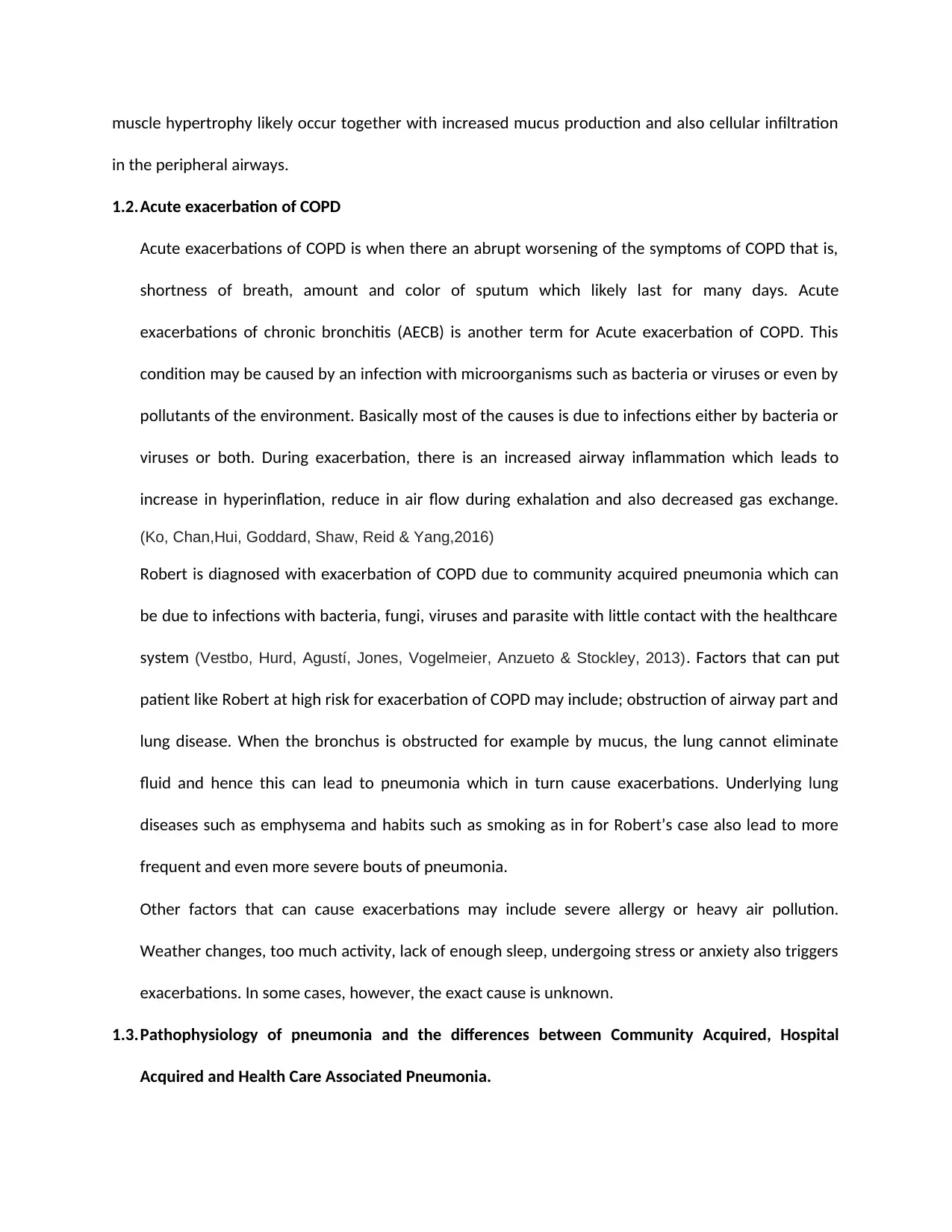
muscle hypertrophy likely occur together with increased mucus production and also cellular infiltration
in the peripheral airways.
1.2.Acute exacerbation of COPD
Acute exacerbations of COPD is when there an abrupt worsening of the symptoms of COPD that is,
shortness of breath, amount and color of sputum which likely last for many days. Acute
exacerbations of chronic bronchitis (AECB) is another term for Acute exacerbation of COPD. This
condition may be caused by an infection with microorganisms such as bacteria or viruses or even by
pollutants of the environment. Basically most of the causes is due to infections either by bacteria or
viruses or both. During exacerbation, there is an increased airway inflammation which leads to
increase in hyperinflation, reduce in air flow during exhalation and also decreased gas exchange.
(Ko, Chan,Hui, Goddard, Shaw, Reid & Yang,2016)
Robert is diagnosed with exacerbation of COPD due to community acquired pneumonia which can
be due to infections with bacteria, fungi, viruses and parasite with little contact with the healthcare
system (Vestbo, Hurd, Agustí, Jones, Vogelmeier, Anzueto & Stockley, 2013). Factors that can put
patient like Robert at high risk for exacerbation of COPD may include; obstruction of airway part and
lung disease. When the bronchus is obstructed for example by mucus, the lung cannot eliminate
fluid and hence this can lead to pneumonia which in turn cause exacerbations. Underlying lung
diseases such as emphysema and habits such as smoking as in for Robert’s case also lead to more
frequent and even more severe bouts of pneumonia.
Other factors that can cause exacerbations may include severe allergy or heavy air pollution.
Weather changes, too much activity, lack of enough sleep, undergoing stress or anxiety also triggers
exacerbations. In some cases, however, the exact cause is unknown.
1.3.Pathophysiology of pneumonia and the differences between Community Acquired, Hospital
Acquired and Health Care Associated Pneumonia.
in the peripheral airways.
1.2.Acute exacerbation of COPD
Acute exacerbations of COPD is when there an abrupt worsening of the symptoms of COPD that is,
shortness of breath, amount and color of sputum which likely last for many days. Acute
exacerbations of chronic bronchitis (AECB) is another term for Acute exacerbation of COPD. This
condition may be caused by an infection with microorganisms such as bacteria or viruses or even by
pollutants of the environment. Basically most of the causes is due to infections either by bacteria or
viruses or both. During exacerbation, there is an increased airway inflammation which leads to
increase in hyperinflation, reduce in air flow during exhalation and also decreased gas exchange.
(Ko, Chan,Hui, Goddard, Shaw, Reid & Yang,2016)
Robert is diagnosed with exacerbation of COPD due to community acquired pneumonia which can
be due to infections with bacteria, fungi, viruses and parasite with little contact with the healthcare
system (Vestbo, Hurd, Agustí, Jones, Vogelmeier, Anzueto & Stockley, 2013). Factors that can put
patient like Robert at high risk for exacerbation of COPD may include; obstruction of airway part and
lung disease. When the bronchus is obstructed for example by mucus, the lung cannot eliminate
fluid and hence this can lead to pneumonia which in turn cause exacerbations. Underlying lung
diseases such as emphysema and habits such as smoking as in for Robert’s case also lead to more
frequent and even more severe bouts of pneumonia.
Other factors that can cause exacerbations may include severe allergy or heavy air pollution.
Weather changes, too much activity, lack of enough sleep, undergoing stress or anxiety also triggers
exacerbations. In some cases, however, the exact cause is unknown.
1.3.Pathophysiology of pneumonia and the differences between Community Acquired, Hospital
Acquired and Health Care Associated Pneumonia.
⊘ This is a preview!⊘
Do you want full access?
Subscribe today to unlock all pages.

Trusted by 1+ million students worldwide
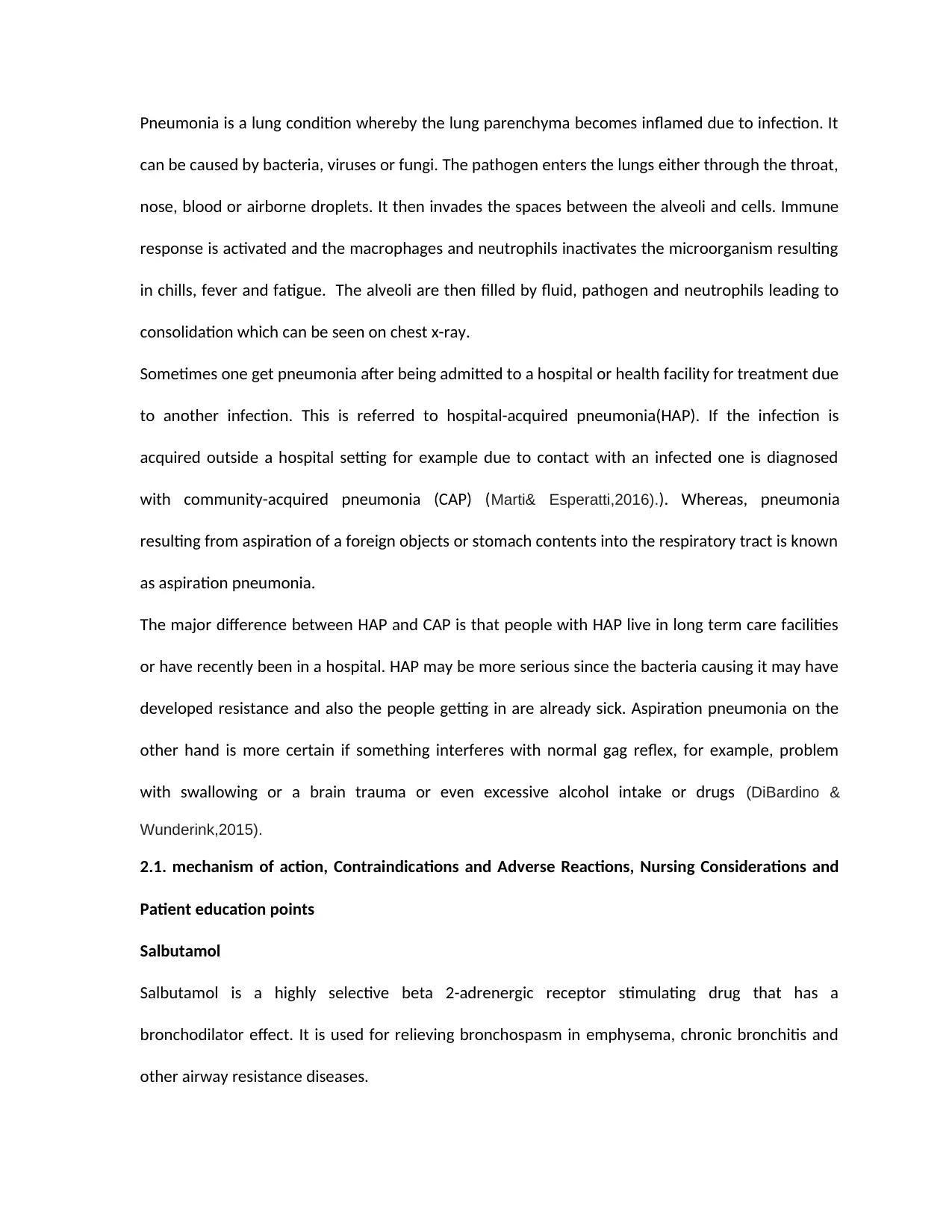
Pneumonia is a lung condition whereby the lung parenchyma becomes inflamed due to infection. It
can be caused by bacteria, viruses or fungi. The pathogen enters the lungs either through the throat,
nose, blood or airborne droplets. It then invades the spaces between the alveoli and cells. Immune
response is activated and the macrophages and neutrophils inactivates the microorganism resulting
in chills, fever and fatigue. The alveoli are then filled by fluid, pathogen and neutrophils leading to
consolidation which can be seen on chest x-ray.
Sometimes one get pneumonia after being admitted to a hospital or health facility for treatment due
to another infection. This is referred to hospital-acquired pneumonia(HAP). If the infection is
acquired outside a hospital setting for example due to contact with an infected one is diagnosed
with community-acquired pneumonia (CAP) (Marti& Esperatti,2016).). Whereas, pneumonia
resulting from aspiration of a foreign objects or stomach contents into the respiratory tract is known
as aspiration pneumonia.
The major difference between HAP and CAP is that people with HAP live in long term care facilities
or have recently been in a hospital. HAP may be more serious since the bacteria causing it may have
developed resistance and also the people getting in are already sick. Aspiration pneumonia on the
other hand is more certain if something interferes with normal gag reflex, for example, problem
with swallowing or a brain trauma or even excessive alcohol intake or drugs (DiBardino &
Wunderink,2015).
2.1. mechanism of action, Contraindications and Adverse Reactions, Nursing Considerations and
Patient education points
Salbutamol
Salbutamol is a highly selective beta 2-adrenergic receptor stimulating drug that has a
bronchodilator effect. It is used for relieving bronchospasm in emphysema, chronic bronchitis and
other airway resistance diseases.
can be caused by bacteria, viruses or fungi. The pathogen enters the lungs either through the throat,
nose, blood or airborne droplets. It then invades the spaces between the alveoli and cells. Immune
response is activated and the macrophages and neutrophils inactivates the microorganism resulting
in chills, fever and fatigue. The alveoli are then filled by fluid, pathogen and neutrophils leading to
consolidation which can be seen on chest x-ray.
Sometimes one get pneumonia after being admitted to a hospital or health facility for treatment due
to another infection. This is referred to hospital-acquired pneumonia(HAP). If the infection is
acquired outside a hospital setting for example due to contact with an infected one is diagnosed
with community-acquired pneumonia (CAP) (Marti& Esperatti,2016).). Whereas, pneumonia
resulting from aspiration of a foreign objects or stomach contents into the respiratory tract is known
as aspiration pneumonia.
The major difference between HAP and CAP is that people with HAP live in long term care facilities
or have recently been in a hospital. HAP may be more serious since the bacteria causing it may have
developed resistance and also the people getting in are already sick. Aspiration pneumonia on the
other hand is more certain if something interferes with normal gag reflex, for example, problem
with swallowing or a brain trauma or even excessive alcohol intake or drugs (DiBardino &
Wunderink,2015).
2.1. mechanism of action, Contraindications and Adverse Reactions, Nursing Considerations and
Patient education points
Salbutamol
Salbutamol is a highly selective beta 2-adrenergic receptor stimulating drug that has a
bronchodilator effect. It is used for relieving bronchospasm in emphysema, chronic bronchitis and
other airway resistance diseases.
Paraphrase This Document
Need a fresh take? Get an instant paraphrase of this document with our AI Paraphraser

Salbutamol works by stimulating beta 2 adrenergic receptors, predominant receptors in bronchial
smooth muscles. These triggers activation of enzyme adenyl cyclase which forms adenosine mono-
phosphate(AMP) from adenosine tri-phosphate(ATP). Increase of cyclic AMP causes the bronchial
smooth muscle to relax and makes the airway resistance decrease by lowering intracellular ionic
calcium concentrations (Gordon,& Panos,2010). The drug relaxes the smooth muscles of the
airways. This increase in the cyclic AMP also inhibits bronchoconstrictor mediators from being
released. These mediators include histamine, leukotriene from mast cells in the airway.
Salbutamol is contraindicated in pregnancy. Studies from animals have shown teratogenic effects on
the fetus. It should be administered only if the potential risk outweighs the potential risk of the
fetus. It is also contraindicated in persons with a history of allergic or hypersensitivity reactions. It
should also not be administered to patients with pre-existing cardiac tachyarrhythmia.
The most common adverse reactions of salbutamol are palpitations, fine tremors, anxiety,
hypertension. Others include headache, cramps, dry mouth, tachycardia, arrhythmia, flushing of the
skin sleep disturbances and rarely myocardial ischemia.
The nurse should assess cardio respiratory function of the client and also determine previous history
of the medication and thereafter monitor for allergic reactions. The nurse should also consider
instructing the patient on dosage and not to overdose. She should also teach the client to use the
inhaler and advise spacing and also to report any allergic reactions. Budesonide
Budesonide/Efomoterol fumarate dehydrate
Budesonide is an anti-inflammatory corticosteroid that portrays potent weak mineralocorticoid
activity and potent glucocorticoid activity. The precise mechanism of actions is unknown but
corticosteroids have been illustrated to have a variety of inhibitory actions against many cell types
such as neutrophils, macrophages and mediators such as histamine, leukotrienes involved in
smooth muscles. These triggers activation of enzyme adenyl cyclase which forms adenosine mono-
phosphate(AMP) from adenosine tri-phosphate(ATP). Increase of cyclic AMP causes the bronchial
smooth muscle to relax and makes the airway resistance decrease by lowering intracellular ionic
calcium concentrations (Gordon,& Panos,2010). The drug relaxes the smooth muscles of the
airways. This increase in the cyclic AMP also inhibits bronchoconstrictor mediators from being
released. These mediators include histamine, leukotriene from mast cells in the airway.
Salbutamol is contraindicated in pregnancy. Studies from animals have shown teratogenic effects on
the fetus. It should be administered only if the potential risk outweighs the potential risk of the
fetus. It is also contraindicated in persons with a history of allergic or hypersensitivity reactions. It
should also not be administered to patients with pre-existing cardiac tachyarrhythmia.
The most common adverse reactions of salbutamol are palpitations, fine tremors, anxiety,
hypertension. Others include headache, cramps, dry mouth, tachycardia, arrhythmia, flushing of the
skin sleep disturbances and rarely myocardial ischemia.
The nurse should assess cardio respiratory function of the client and also determine previous history
of the medication and thereafter monitor for allergic reactions. The nurse should also consider
instructing the patient on dosage and not to overdose. She should also teach the client to use the
inhaler and advise spacing and also to report any allergic reactions. Budesonide
Budesonide/Efomoterol fumarate dehydrate
Budesonide is an anti-inflammatory corticosteroid that portrays potent weak mineralocorticoid
activity and potent glucocorticoid activity. The precise mechanism of actions is unknown but
corticosteroids have been illustrated to have a variety of inhibitory actions against many cell types
such as neutrophils, macrophages and mediators such as histamine, leukotrienes involved in
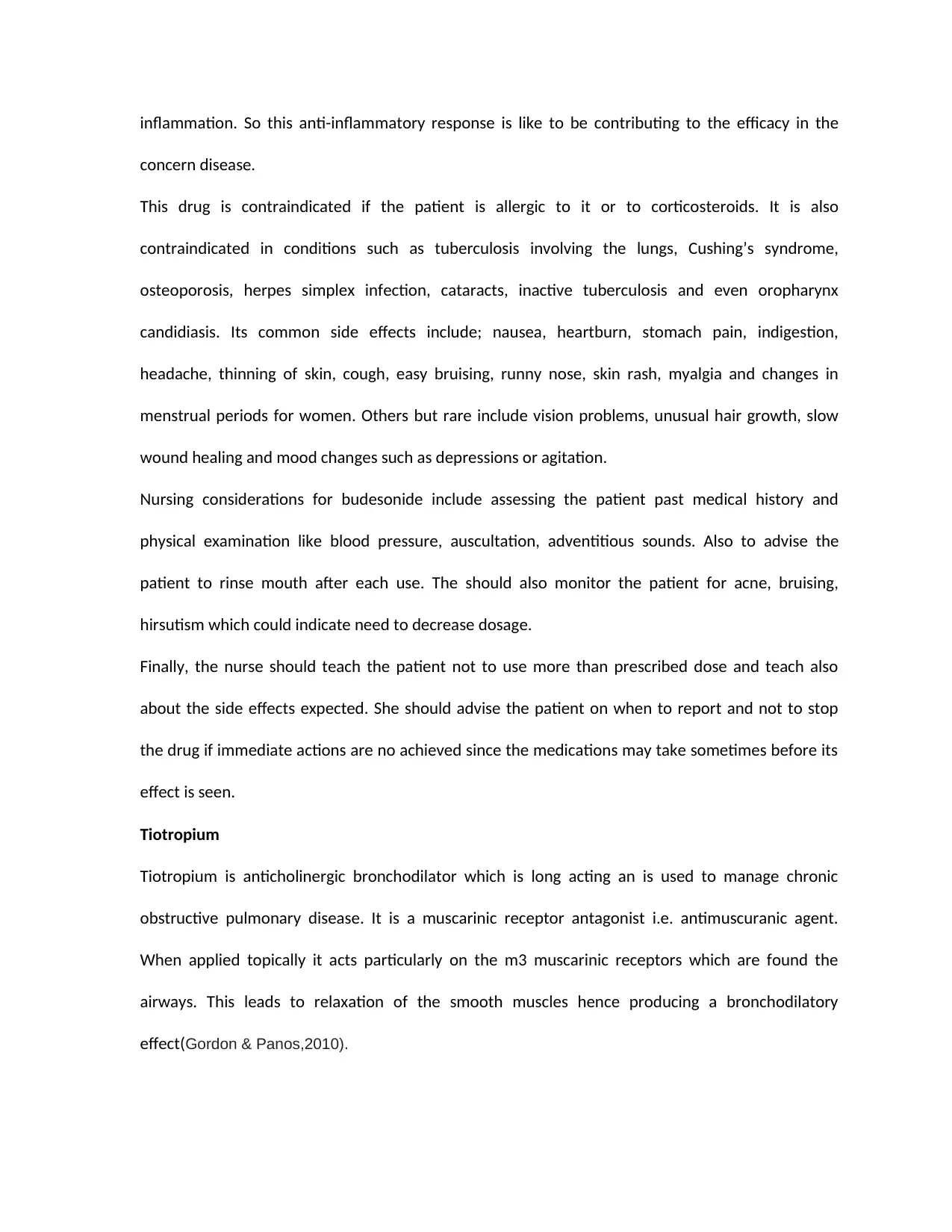
inflammation. So this anti-inflammatory response is like to be contributing to the efficacy in the
concern disease.
This drug is contraindicated if the patient is allergic to it or to corticosteroids. It is also
contraindicated in conditions such as tuberculosis involving the lungs, Cushing’s syndrome,
osteoporosis, herpes simplex infection, cataracts, inactive tuberculosis and even oropharynx
candidiasis. Its common side effects include; nausea, heartburn, stomach pain, indigestion,
headache, thinning of skin, cough, easy bruising, runny nose, skin rash, myalgia and changes in
menstrual periods for women. Others but rare include vision problems, unusual hair growth, slow
wound healing and mood changes such as depressions or agitation.
Nursing considerations for budesonide include assessing the patient past medical history and
physical examination like blood pressure, auscultation, adventitious sounds. Also to advise the
patient to rinse mouth after each use. The should also monitor the patient for acne, bruising,
hirsutism which could indicate need to decrease dosage.
Finally, the nurse should teach the patient not to use more than prescribed dose and teach also
about the side effects expected. She should advise the patient on when to report and not to stop
the drug if immediate actions are no achieved since the medications may take sometimes before its
effect is seen.
Tiotropium
Tiotropium is anticholinergic bronchodilator which is long acting an is used to manage chronic
obstructive pulmonary disease. It is a muscarinic receptor antagonist i.e. antimuscuranic agent.
When applied topically it acts particularly on the m3 muscarinic receptors which are found the
airways. This leads to relaxation of the smooth muscles hence producing a bronchodilatory
effect(Gordon & Panos,2010).
concern disease.
This drug is contraindicated if the patient is allergic to it or to corticosteroids. It is also
contraindicated in conditions such as tuberculosis involving the lungs, Cushing’s syndrome,
osteoporosis, herpes simplex infection, cataracts, inactive tuberculosis and even oropharynx
candidiasis. Its common side effects include; nausea, heartburn, stomach pain, indigestion,
headache, thinning of skin, cough, easy bruising, runny nose, skin rash, myalgia and changes in
menstrual periods for women. Others but rare include vision problems, unusual hair growth, slow
wound healing and mood changes such as depressions or agitation.
Nursing considerations for budesonide include assessing the patient past medical history and
physical examination like blood pressure, auscultation, adventitious sounds. Also to advise the
patient to rinse mouth after each use. The should also monitor the patient for acne, bruising,
hirsutism which could indicate need to decrease dosage.
Finally, the nurse should teach the patient not to use more than prescribed dose and teach also
about the side effects expected. She should advise the patient on when to report and not to stop
the drug if immediate actions are no achieved since the medications may take sometimes before its
effect is seen.
Tiotropium
Tiotropium is anticholinergic bronchodilator which is long acting an is used to manage chronic
obstructive pulmonary disease. It is a muscarinic receptor antagonist i.e. antimuscuranic agent.
When applied topically it acts particularly on the m3 muscarinic receptors which are found the
airways. This leads to relaxation of the smooth muscles hence producing a bronchodilatory
effect(Gordon & Panos,2010).
⊘ This is a preview!⊘
Do you want full access?
Subscribe today to unlock all pages.

Trusted by 1+ million students worldwide
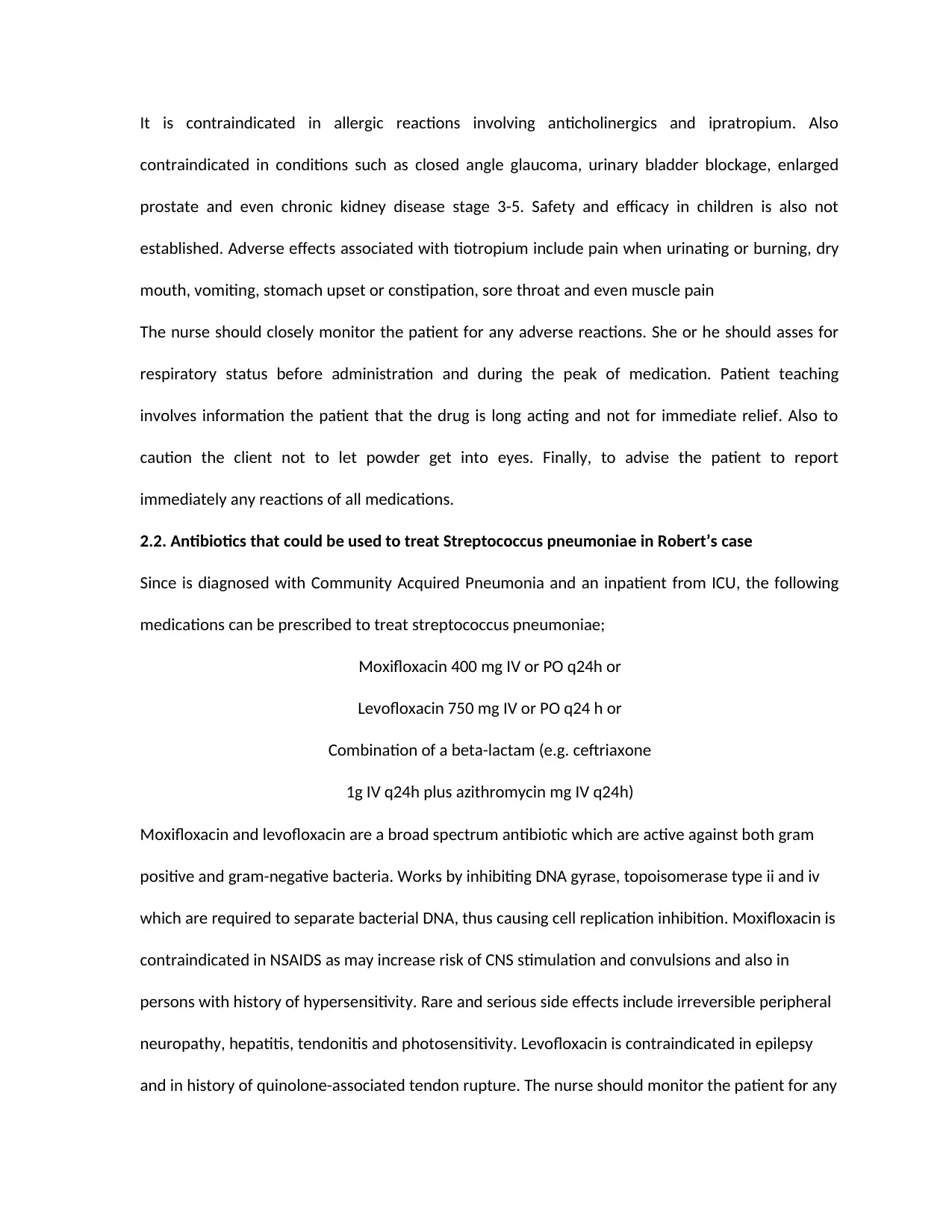
It is contraindicated in allergic reactions involving anticholinergics and ipratropium. Also
contraindicated in conditions such as closed angle glaucoma, urinary bladder blockage, enlarged
prostate and even chronic kidney disease stage 3-5. Safety and efficacy in children is also not
established. Adverse effects associated with tiotropium include pain when urinating or burning, dry
mouth, vomiting, stomach upset or constipation, sore throat and even muscle pain
The nurse should closely monitor the patient for any adverse reactions. She or he should asses for
respiratory status before administration and during the peak of medication. Patient teaching
involves information the patient that the drug is long acting and not for immediate relief. Also to
caution the client not to let powder get into eyes. Finally, to advise the patient to report
immediately any reactions of all medications.
2.2. Antibiotics that could be used to treat Streptococcus pneumoniae in Robert’s case
Since is diagnosed with Community Acquired Pneumonia and an inpatient from ICU, the following
medications can be prescribed to treat streptococcus pneumoniae;
Moxifloxacin 400 mg IV or PO q24h or
Levofloxacin 750 mg IV or PO q24 h or
Combination of a beta-lactam (e.g. ceftriaxone
1g IV q24h plus azithromycin mg IV q24h)
Moxifloxacin and levofloxacin are a broad spectrum antibiotic which are active against both gram
positive and gram-negative bacteria. Works by inhibiting DNA gyrase, topoisomerase type ii and iv
which are required to separate bacterial DNA, thus causing cell replication inhibition. Moxifloxacin is
contraindicated in NSAIDS as may increase risk of CNS stimulation and convulsions and also in
persons with history of hypersensitivity. Rare and serious side effects include irreversible peripheral
neuropathy, hepatitis, tendonitis and photosensitivity. Levofloxacin is contraindicated in epilepsy
and in history of quinolone-associated tendon rupture. The nurse should monitor the patient for any
contraindicated in conditions such as closed angle glaucoma, urinary bladder blockage, enlarged
prostate and even chronic kidney disease stage 3-5. Safety and efficacy in children is also not
established. Adverse effects associated with tiotropium include pain when urinating or burning, dry
mouth, vomiting, stomach upset or constipation, sore throat and even muscle pain
The nurse should closely monitor the patient for any adverse reactions. She or he should asses for
respiratory status before administration and during the peak of medication. Patient teaching
involves information the patient that the drug is long acting and not for immediate relief. Also to
caution the client not to let powder get into eyes. Finally, to advise the patient to report
immediately any reactions of all medications.
2.2. Antibiotics that could be used to treat Streptococcus pneumoniae in Robert’s case
Since is diagnosed with Community Acquired Pneumonia and an inpatient from ICU, the following
medications can be prescribed to treat streptococcus pneumoniae;
Moxifloxacin 400 mg IV or PO q24h or
Levofloxacin 750 mg IV or PO q24 h or
Combination of a beta-lactam (e.g. ceftriaxone
1g IV q24h plus azithromycin mg IV q24h)
Moxifloxacin and levofloxacin are a broad spectrum antibiotic which are active against both gram
positive and gram-negative bacteria. Works by inhibiting DNA gyrase, topoisomerase type ii and iv
which are required to separate bacterial DNA, thus causing cell replication inhibition. Moxifloxacin is
contraindicated in NSAIDS as may increase risk of CNS stimulation and convulsions and also in
persons with history of hypersensitivity. Rare and serious side effects include irreversible peripheral
neuropathy, hepatitis, tendonitis and photosensitivity. Levofloxacin is contraindicated in epilepsy
and in history of quinolone-associated tendon rupture. The nurse should monitor the patient for any
Paraphrase This Document
Need a fresh take? Get an instant paraphrase of this document with our AI Paraphraser
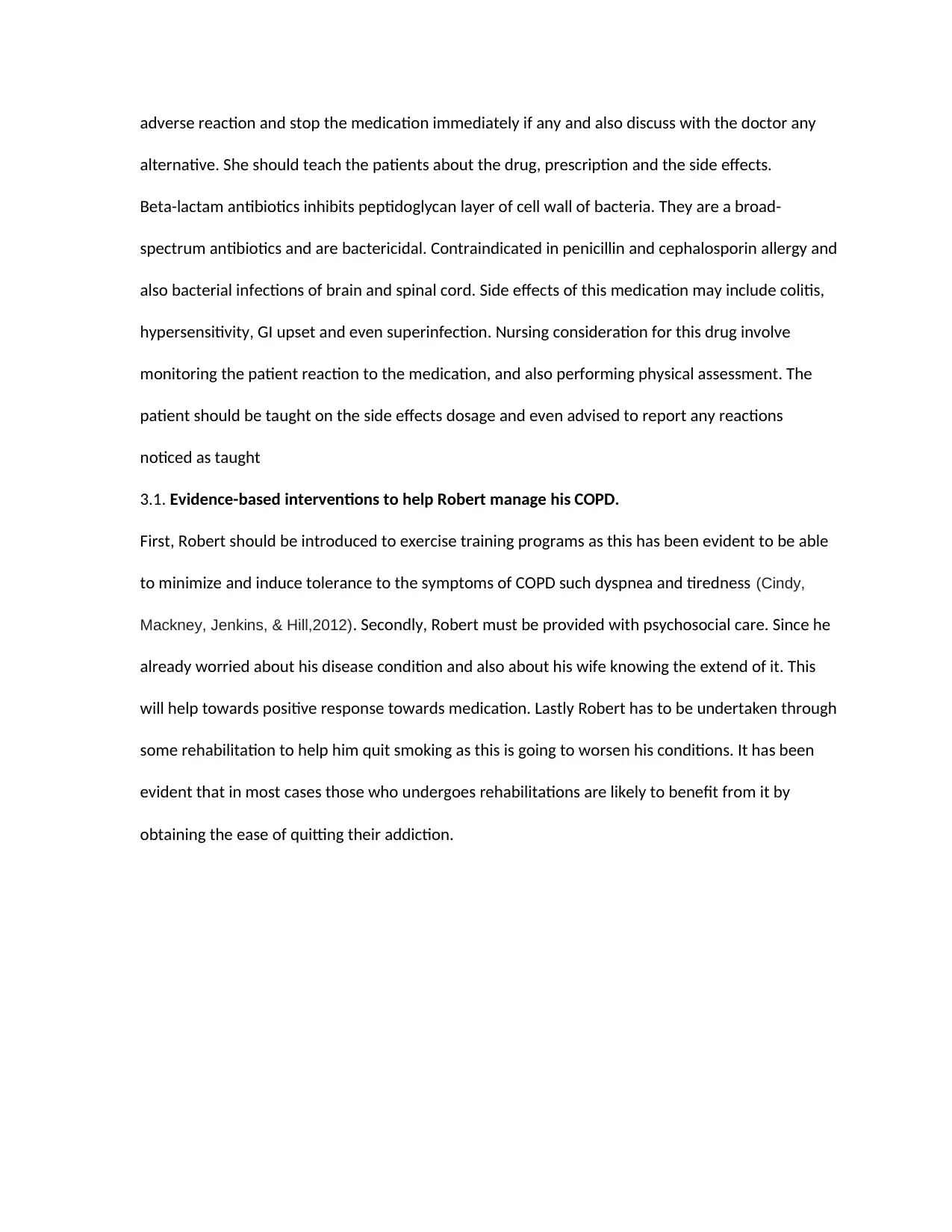
adverse reaction and stop the medication immediately if any and also discuss with the doctor any
alternative. She should teach the patients about the drug, prescription and the side effects.
Beta-lactam antibiotics inhibits peptidoglycan layer of cell wall of bacteria. They are a broad-
spectrum antibiotics and are bactericidal. Contraindicated in penicillin and cephalosporin allergy and
also bacterial infections of brain and spinal cord. Side effects of this medication may include colitis,
hypersensitivity, GI upset and even superinfection. Nursing consideration for this drug involve
monitoring the patient reaction to the medication, and also performing physical assessment. The
patient should be taught on the side effects dosage and even advised to report any reactions
noticed as taught
3.1. Evidence-based interventions to help Robert manage his COPD.
First, Robert should be introduced to exercise training programs as this has been evident to be able
to minimize and induce tolerance to the symptoms of COPD such dyspnea and tiredness (Cindy,
Mackney, Jenkins, & Hill,2012). Secondly, Robert must be provided with psychosocial care. Since he
already worried about his disease condition and also about his wife knowing the extend of it. This
will help towards positive response towards medication. Lastly Robert has to be undertaken through
some rehabilitation to help him quit smoking as this is going to worsen his conditions. It has been
evident that in most cases those who undergoes rehabilitations are likely to benefit from it by
obtaining the ease of quitting their addiction.
alternative. She should teach the patients about the drug, prescription and the side effects.
Beta-lactam antibiotics inhibits peptidoglycan layer of cell wall of bacteria. They are a broad-
spectrum antibiotics and are bactericidal. Contraindicated in penicillin and cephalosporin allergy and
also bacterial infections of brain and spinal cord. Side effects of this medication may include colitis,
hypersensitivity, GI upset and even superinfection. Nursing consideration for this drug involve
monitoring the patient reaction to the medication, and also performing physical assessment. The
patient should be taught on the side effects dosage and even advised to report any reactions
noticed as taught
3.1. Evidence-based interventions to help Robert manage his COPD.
First, Robert should be introduced to exercise training programs as this has been evident to be able
to minimize and induce tolerance to the symptoms of COPD such dyspnea and tiredness (Cindy,
Mackney, Jenkins, & Hill,2012). Secondly, Robert must be provided with psychosocial care. Since he
already worried about his disease condition and also about his wife knowing the extend of it. This
will help towards positive response towards medication. Lastly Robert has to be undertaken through
some rehabilitation to help him quit smoking as this is going to worsen his conditions. It has been
evident that in most cases those who undergoes rehabilitations are likely to benefit from it by
obtaining the ease of quitting their addiction.
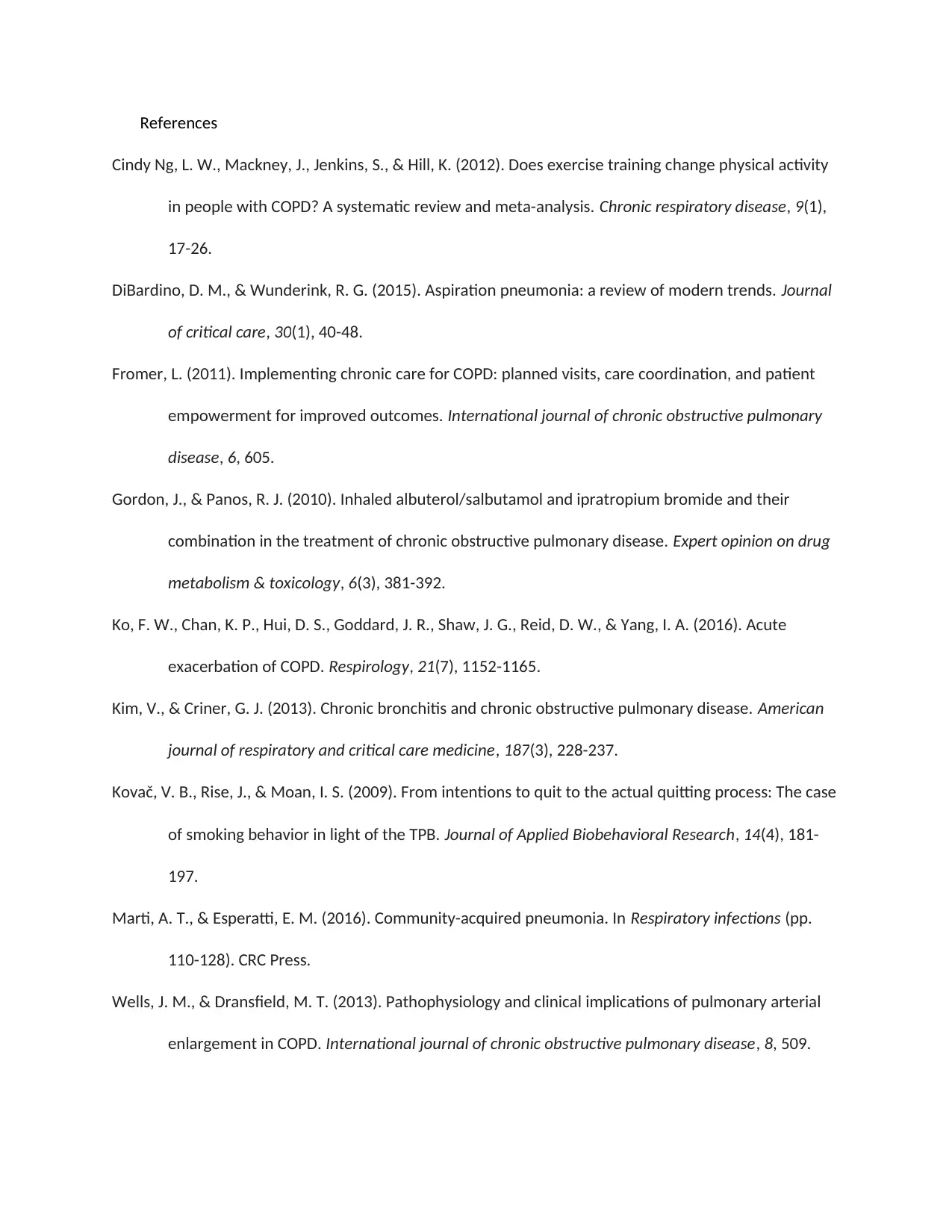
References
Cindy Ng, L. W., Mackney, J., Jenkins, S., & Hill, K. (2012). Does exercise training change physical activity
in people with COPD? A systematic review and meta-analysis. Chronic respiratory disease, 9(1),
17-26.
DiBardino, D. M., & Wunderink, R. G. (2015). Aspiration pneumonia: a review of modern trends. Journal
of critical care, 30(1), 40-48.
Fromer, L. (2011). Implementing chronic care for COPD: planned visits, care coordination, and patient
empowerment for improved outcomes. International journal of chronic obstructive pulmonary
disease, 6, 605.
Gordon, J., & Panos, R. J. (2010). Inhaled albuterol/salbutamol and ipratropium bromide and their
combination in the treatment of chronic obstructive pulmonary disease. Expert opinion on drug
metabolism & toxicology, 6(3), 381-392.
Ko, F. W., Chan, K. P., Hui, D. S., Goddard, J. R., Shaw, J. G., Reid, D. W., & Yang, I. A. (2016). Acute
exacerbation of COPD. Respirology, 21(7), 1152-1165.
Kim, V., & Criner, G. J. (2013). Chronic bronchitis and chronic obstructive pulmonary disease. American
journal of respiratory and critical care medicine, 187(3), 228-237.
Kovač, V. B., Rise, J., & Moan, I. S. (2009). From intentions to quit to the actual quitting process: The case
of smoking behavior in light of the TPB. Journal of Applied Biobehavioral Research, 14(4), 181-
197.
Marti, A. T., & Esperatti, E. M. (2016). Community-acquired pneumonia. In Respiratory infections (pp.
110-128). CRC Press.
Wells, J. M., & Dransfield, M. T. (2013). Pathophysiology and clinical implications of pulmonary arterial
enlargement in COPD. International journal of chronic obstructive pulmonary disease, 8, 509.
Cindy Ng, L. W., Mackney, J., Jenkins, S., & Hill, K. (2012). Does exercise training change physical activity
in people with COPD? A systematic review and meta-analysis. Chronic respiratory disease, 9(1),
17-26.
DiBardino, D. M., & Wunderink, R. G. (2015). Aspiration pneumonia: a review of modern trends. Journal
of critical care, 30(1), 40-48.
Fromer, L. (2011). Implementing chronic care for COPD: planned visits, care coordination, and patient
empowerment for improved outcomes. International journal of chronic obstructive pulmonary
disease, 6, 605.
Gordon, J., & Panos, R. J. (2010). Inhaled albuterol/salbutamol and ipratropium bromide and their
combination in the treatment of chronic obstructive pulmonary disease. Expert opinion on drug
metabolism & toxicology, 6(3), 381-392.
Ko, F. W., Chan, K. P., Hui, D. S., Goddard, J. R., Shaw, J. G., Reid, D. W., & Yang, I. A. (2016). Acute
exacerbation of COPD. Respirology, 21(7), 1152-1165.
Kim, V., & Criner, G. J. (2013). Chronic bronchitis and chronic obstructive pulmonary disease. American
journal of respiratory and critical care medicine, 187(3), 228-237.
Kovač, V. B., Rise, J., & Moan, I. S. (2009). From intentions to quit to the actual quitting process: The case
of smoking behavior in light of the TPB. Journal of Applied Biobehavioral Research, 14(4), 181-
197.
Marti, A. T., & Esperatti, E. M. (2016). Community-acquired pneumonia. In Respiratory infections (pp.
110-128). CRC Press.
Wells, J. M., & Dransfield, M. T. (2013). Pathophysiology and clinical implications of pulmonary arterial
enlargement in COPD. International journal of chronic obstructive pulmonary disease, 8, 509.
⊘ This is a preview!⊘
Do you want full access?
Subscribe today to unlock all pages.

Trusted by 1+ million students worldwide
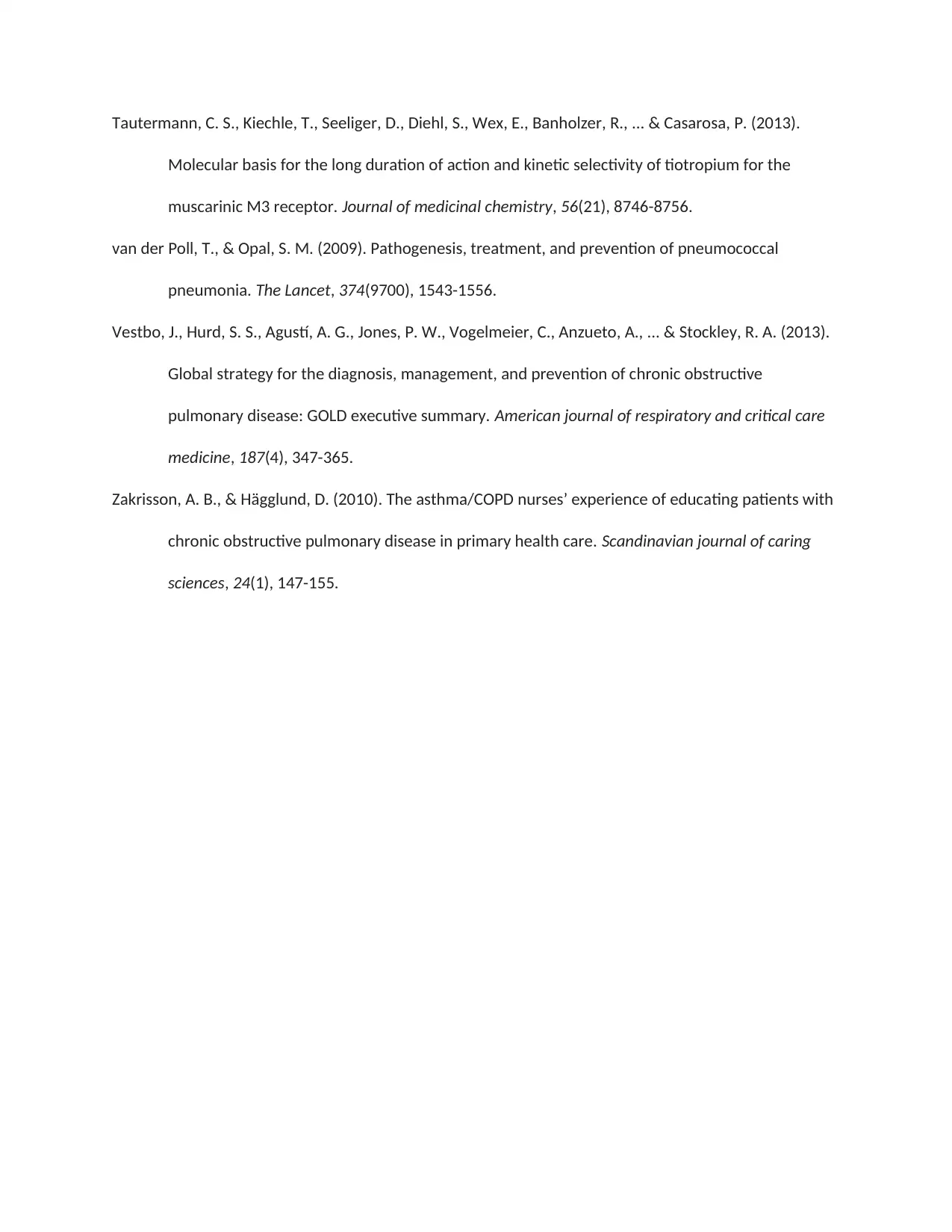
Tautermann, C. S., Kiechle, T., Seeliger, D., Diehl, S., Wex, E., Banholzer, R., ... & Casarosa, P. (2013).
Molecular basis for the long duration of action and kinetic selectivity of tiotropium for the
muscarinic M3 receptor. Journal of medicinal chemistry, 56(21), 8746-8756.
van der Poll, T., & Opal, S. M. (2009). Pathogenesis, treatment, and prevention of pneumococcal
pneumonia. The Lancet, 374(9700), 1543-1556.
Vestbo, J., Hurd, S. S., Agustí, A. G., Jones, P. W., Vogelmeier, C., Anzueto, A., ... & Stockley, R. A. (2013).
Global strategy for the diagnosis, management, and prevention of chronic obstructive
pulmonary disease: GOLD executive summary. American journal of respiratory and critical care
medicine, 187(4), 347-365.
Zakrisson, A. B., & Hägglund, D. (2010). The asthma/COPD nurses’ experience of educating patients with
chronic obstructive pulmonary disease in primary health care. Scandinavian journal of caring
sciences, 24(1), 147-155.
Molecular basis for the long duration of action and kinetic selectivity of tiotropium for the
muscarinic M3 receptor. Journal of medicinal chemistry, 56(21), 8746-8756.
van der Poll, T., & Opal, S. M. (2009). Pathogenesis, treatment, and prevention of pneumococcal
pneumonia. The Lancet, 374(9700), 1543-1556.
Vestbo, J., Hurd, S. S., Agustí, A. G., Jones, P. W., Vogelmeier, C., Anzueto, A., ... & Stockley, R. A. (2013).
Global strategy for the diagnosis, management, and prevention of chronic obstructive
pulmonary disease: GOLD executive summary. American journal of respiratory and critical care
medicine, 187(4), 347-365.
Zakrisson, A. B., & Hägglund, D. (2010). The asthma/COPD nurses’ experience of educating patients with
chronic obstructive pulmonary disease in primary health care. Scandinavian journal of caring
sciences, 24(1), 147-155.
1 out of 10
Related Documents
Your All-in-One AI-Powered Toolkit for Academic Success.
+13062052269
info@desklib.com
Available 24*7 on WhatsApp / Email
![[object Object]](/_next/static/media/star-bottom.7253800d.svg)
Unlock your academic potential
Copyright © 2020–2025 A2Z Services. All Rights Reserved. Developed and managed by ZUCOL.





